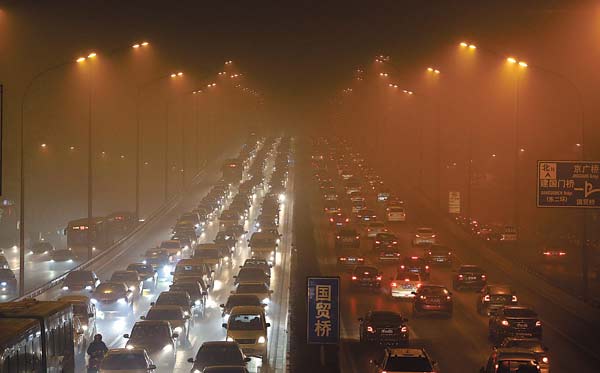Healthy debate over air
Updated: 2013-01-14 00:57
(China Daily)
|
|||||||||||
Record pollution levels hit transport as face mask sales surge, report Wu Wencong, Tang Yue and Cui Jia.
For many years, Peking Duck and Peking Opera were probably the two most famous items named after the capital.
However, they now face a strong challenge. The heavy smog and haze that enveloped the city on the weekend — pushing the pollution index to a record high — has seen "Beijing Cough", a term coined by the city's expat community, becoming increasingly popular with local media and Chinese citizens.
 |
| The capital's Third Ring Road is shrouded in haze on Saturday as the city's air pollution reached hazardous levels. [Agencies] |
Saturday saw the density of PM2.5 — air particles smaller than 2.5 microns and able to enter the lungs and even the blood stream — climb higher than 900 micrograms per cubic meter in several districts in the capital, according to the Beijing Municipal Environmental Monitoring Center. That's the highest level recorded since Beijing began publishing the data in early 2012.
The World Health Organization considers the safe daily level to be 25 micrograms per cubic meter.
However, the problem has now become a national phenomenon, rather than one unique to Beijing. On Saturday, levels of PM2.5 passed 300 micrograms per cubic meter in 33 of the 74 cities with systems equipped to monitor the particles.
The heavy smog saw at least 25 international and domestic flights to and from Beijing Capital International Airport cancelled by Sunday morning. Many highways were closed in Shandong and Jiangxi provinces, and the poor visibility resulted in a number of collisions on Sunday morning, claiming one life in Shaoyang, Hunan province.
China will have to endure this hazardous weather until Jan 16, when cold fronts move into the central and eastern parts of the country, according to Ma Xuekuan, chief weather forecaster at the National Meteorological Center, on Sunday.
Face masks
"If he hadn't had a fever today, I wouldn't have brought him to the hospital. I'm afraid the pollution will only make his cough worse," said the mother of a 7-year-old boy being treated at the China-Japan Friendship Hospital on Sunday. Parents and children at the hospital wore face masks.
"It only takes me 10 minutes to cycle to work, but when I get home my mask is gray and filthy. It's just terrible," she said.
Hospitals in Beijing and in the provinces of Hebei and Hubei have reported a rise in the number of patients with respiratory conditions during recent days, according to local media.
In 2012, an estimated 8,572 premature deaths occurred in Shanghai, Guangzhou, Xi'an and Beijing. They were a direct result of high levels of PM2.5, according to a report co-authored by Peking University's School of Public Health and Greenpeace. Meanwhile, the World Health Organization estimates that air pollution caused approximately 470,000 premature deaths in 2008.
Continuous, large-scale pollution in the form of smog will create panic among the public and cause people to question the government's handling of environmental issues, according to the China Council for International Cooperation on Environment and Development.
The growth and severity of PM2.5 pollution in recent years is directly related to the rapid rise in coal consumption, allied to an increase in vehicle exhaust emissions. Although cities such as Beijing and Guangzhou are leading the way in the reduction of coal use in absolute terms, air pollution naturally moves with the air currents, meaning some cities share each other's polluted air. The Ministry of Environmental Protection is encouraging places such as the Beijing-Tianjin-Hebei region, the Yangtze River Delta and the Pearl River Delta to unite to combat pollution.
Since the start of the month, 74 large cities in China have provided daily readings of PM2.5 that are available to the public. As the data becomes more widely available, China is working on a national surveillance and risk-assessment network on the health impact of PM2.5, said Xu Dongqun, deputy director of the institute of environmental health and related product safety at the Chinese Center for Disease Control and Prevention.
"The planned network, the first of its kind on the mainland, will study the exact links between major pollutants, particularly PM2.5 and help the authorities to issue public health warnings ahead of the worst days whenever possible," she said.
By studying data from air-quality monitoring stations and records of hospital visits, plus medical and mortality records, the system will provide specific warnings and advice to help the public to protect themselves, explained Xu, although she was unable to provide an exact timetable.
The network will start in Beijing, before being rolled out nationwide as the air-quality monitoring data become more widely available across the mainland, she said. "The health impact of the fine particulates varies regionally and among differing population groups."
Related Stories
Beijing air pollution reaches dangerous levels 2013-01-13 16:17
Fog, haze lead to big spike in pollution levels 2013-01-12 08:14
Heavily polluted air in Beijing 2013-01-11 16:54
Fog disrupts air traffic in Yunnan 2013-01-04 10:13
Beijing air quality improves for 14th consecutive year 2012-12-31 18:10
Today's Top News
Police continue manhunt for 2nd bombing suspect
H7N9 flu transmission studied
8% growth predicted for Q2
Nuke reactor gets foreign contract
First couple on Time's list of most influential
'Green' awareness levels drop in Beijing
Palace Museum spruces up
Trading channels 'need to broaden'
Hot Topics
Lunar probe , China growth forecasts, Emission rules get tougher, China seen through 'colored lens', International board,
Editor's Picks

|

|

|

|

|

|





